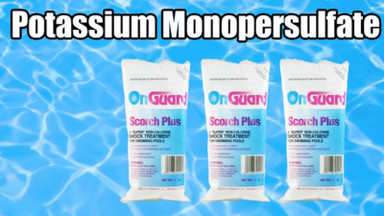The Beauty of Potassium Monopersulfate
Published by EZ Pool & Spa Supply on 05/15/2017
Posted in: OnGuard Scorch Plus, pool sanitation, potassium monopersulfate, Water Chemistry
There are some who have turned to potassium monopersulfate (KMPS or MPS) as a means for shocking their pools. KMPS is a non-chlorine oxidizer, whose chemical formula is KHSO5. It is a strong oxidant with an oxidation potential of similar magnitude to that of chlorine. While it is a powerful oxidizer, there are several important points to consider about this chemical.
“KMPS is used to shock pools for a variety of reasons. Some use it to avoid using chlorine.”
When chlorine is used to oxidize pool water, it reacts with bather and other organic wastes, which are primarily nitrogen based compounds, to form chloramines. These by-products have a foul odor and are considered unpleasant. KMPS also reacts with the nitrogen- based compounds introduced by bathers, but because it does not contain chlorine, does not form chloramines in its oxidation process. Actually,
Potassium Monopersulfate
oxidizes chloramines as well as urea, the active ingredient in urine, according to John Wojtowitc, water chemist. It reacts very slowly with ammonia. KMPS’s lifetime in pool water depends on the quantity of oxidizable material. All things being equal, however, it is not nearly as sensitive to sunlight as chlorine. Unstabilized chlorine is more than 90 percent decomposed within a few hours, while KMPS is about 23 percent decomposed per hour, according to Wojtowitc.
One of its greatest advantages is that bathers can reenter the water a short time after it has been added — typically about 30 minutes.
Also, it dissolves quickly, and does not fade liners. It works well with chlorine, arguably allowing chlorine to work more efficiently as a sanitizer. Using KMPS is highly recommended for indoor pools, where there is no sunlight or wind to help break down and carry away combined chlorine. For indoor pools, shocking with KMPS is recommended about once a week.
Related Product
For indoor pools, shocking with KMPS is recommended about once a week.
KMPS has several important disadvantages and limitations. While it does oxidize and break down urea and chloramines, nitrate ions are the main oxidation product. This is an important point to consider because like phosphates, nitrates are great algae food.
Furthermore, it lowers the pH and the total alkalinity. KMPS shows up as combined chlorine in the DPD test and as free chlorine in the FAS-DPD test. It oxidizes and reacts with one of the reagents. This interference can be removed, however, and service technicians should be aware of this point.
Lastly, it is expensive. Depending on the quantity purchased, it ranges from $3 to $5 per pound.
The recommended shock dose of 1 lb per 10,000 gallons of water provides only 1/3 of the oxidizing power of 1 lb of 65 percent calcium hypochlorite.
For all its limitations, KMPS does have its uses. The most important point to remember is that while it is certainly a strong oxidant, it is NOT a sanitizer, and therefore provides no protection against bacteria and viruses.



